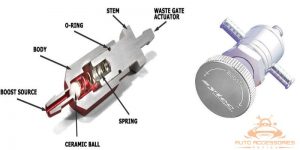In a Boost controller, a turbo charger is connected to a wastegate via vacuum line. Now this is what is known as the wastegate pressure. This means that there is nothing impeding or interrupting the flow from the turbo charge to the waste gate, i.e. positive manifold pressure going to the waste gates open up the spring
How Does A Boost Controller Work – Detailed Discussion
Waste gate and wastegate actuator
The simplest setup consists of a wastegate and wastegate actuator. The waste gate actuator has an arm that is directly connected to the waste gate. Inside the actuator there is a spring and a diaphragm. The spring senses boost pressure all the time because it is connected to the compressor side of the turbo through this hose. So any boost pressure generated by the turbo is exerted on the spring as well. The spring in this particular actuator is an 11 psi spring. This means that the waste gate will be fully opened when the turbo generates 11 psi of boost pressure. So, it’s a really simple setup.
Unfortunately, being simple is it’s only advantage and having your turbo spool up quickly with a setup like this is almost impossible. The reason is that the wastegate actuator spring is exposed to boost pressure constantly. And although the waste gate will be fully opened at 11 psi, it will actually start to open at boost pressures well below that.
This is bad and you do not want your wastegate opening before reaching target boost pressure because once the wastegate opens, it’s going to divert exhaust gases away from the turbine wheel, causing your turbo to spill up slower. Another major drawback of the system is that it is dumb. It only refers to boost pressure. It has no idea about the intake air temperature or how much the throttle is open. This negatively impacts boost pressure.
Manual boost controllers

To make more spring than the actuator is rated at, a manual boost control will do the job. It’s a simple device that is installed in a line between the boost reassure source and a wastegate actuator. It usually features some form of manual adjustment, often an adjustment knob on top of the controller. Inside it there’s a little ball and a little spring. Changing the adjustment of the manual boost controller changes the amount of spring pressure exerted into the little ball. The little ball delays boost pressure from reaching the wastegate actuator.
The turbo is forced to generate 14 psi to raise the ball off the seat and reach the wastegate actuator. When you combine a manual boost controller with an aftermarket wastegate actuator that can house different springs inside it, it really has the potential to change the nature of your turbo charged engine but as you’ll see, it’s far from perfect although it does increase boost, the manual boost controller doesn’t really do anything else like a previous level 1 setup, the manual controller is dumb, it references nothing more than boost pressure and there is nothing controlling the manual boost controller and what can happen with a manual boost controller is that sometimes you can achieve full boost with half throttle and although this might sound cool, it’s really not because it takes away your ability to modulate power which means the car can be very challenging to drive. Another problem with manual boost controllers is that they can require frequent re adjustments. A setting that is in one temperature and elevation might not work in another setting. This problem can be especially pronounced if you drive your car year round in a place that has hot summers and cold winters. The reason behind this again is that the manual boost controller is dumb. So it can’t compensate for changes in ambient temperature or pressure at the end of the day, it’s just one more spring that delays the compression of the original spring so you again end up with a single boost value that can’t be changed or controlled as you drive.
2 port boost control solenoid
Just like any solenoid, this features a coil of wire wrapped around the ferrous metal. When current passes through the wire, it creates a magnetic field that moves the ferrous metal. In essence, a solenoid converts electrical energy to mechanical work or movement.
In the case of a boost control solenoid, a plunger of some sort is usually attached to the ferrous metal and the plunger opens or blocks a passageway through which pressurized air from the turbocharger flows. A two port solenoid is usually connected between the boost pressure source and wastegate actuator with a T-fitting and what it actually does is that it bleeds pressurized air away from the hose,reducing the pressure inside the hose. This means that the wastegate actuator spring actually feels less pressure than what the turbo is generating. This then forces the turbo to generate more pressure than what the wastegate actuator spring is actually rated at in order to open the wastegate.
Now a solenoid has 2 major advantages over any manual boost controller. The first advantage is that it connects to an ECU. The second advantage is that it can vary the amount of air it’s bleeding from the system. You may think that the plunger inside the solenoid is either open or closed . But in reality, what the plunger does is that it rapidly moves between the open and closed positions many many times per second. The amount of time the plunger spends at the open position within a single second represents the solenoids beauty cycle. The longer the solenoid is energized or the longer it is in the open or on position, the more air it will bleed for the system.Basically, it means that the actuator spring will see less pressure resulting in it opening later and this will enable the turbo to generate more boost. Since the solenoid is disconnected to the ECU, the ECU can manipulate the duty cycle of the solenoid to manipulate the amount of air being bleed from the system and thus boost pressure.
Now the ECU references a bunch of different parameters which means it controls boost pressure based on those parameters for example the ECU can manipulate the duty cycle of the solenoid until it reaches the desired pressure in your intake manifold. Besides, because the ECU also references your throttle position, it means that you will never again experience the problem of full boost at half throttle. With an electronic boost control solenoid, these ECU’s also reference your intake air temperature and your cooling temperature that means your performance will not vary like it would in a manual boost controller.
3 port boost control solenoid
The working principle is the same because this too is a solenoid but the connection and obviously the number of ports isn’t unlike the 2 port solenoid which needs a T-fitting to be connected into the system the 3 port solenoid doesn’t need. A T- fitting is connected directly into the boost reference line. In fact, it interrupts the boost pressure going through this line . The 3 port solenoid can do this because it has an additional port which vents gg pressurized air into the atmosphere or back to the turbo inlet as you see here the three port solenoid is connected to a single port internal wastegate actuator, but you can also connect it to a 2 port external wastegate or a 2 port internal actuator when the 3 port solenoid is energized it interrupts or blocks the pressurized air going to the actuator spring by directly interrupting the air and venting into the atmosphere. The three port solenoid can keep more boost pressure off the actuator which means it can help your setup generate more boost.
Typically a three port solenoid connected in this way will allow your turbo to generate twice the boost pressure of what your actuator spring is rated at. So if you’re running an 11 psi spring like this one using a 3 port solenoid can typically generate around 22 psi of boost pressure. Double the boost pressure is usually the limit because beyond this point, what often happens is that the actual exhaust gases generated by the engine itself will overpower the spring and open the wastegate additionally because the 3 port solenoid interrupts pressurized air instead of bleeding it results in a more responsive and a quicker spooling turbo. It is both more accurate and requires less duty cycle to achieve the same boost pressures compared to a 2 port solid, which means it can give you more headroom to increase boost pressure and power combined with an aftermarket wastegate actuator that can house different springs. A three port solenoid will give you a lot of flexibility and a lot of room to grow.










Leave a Comment